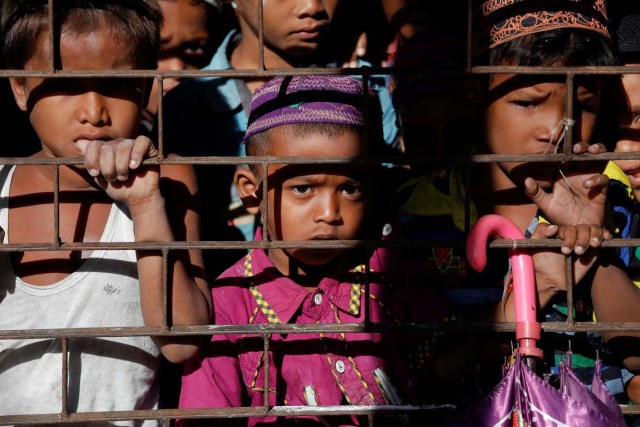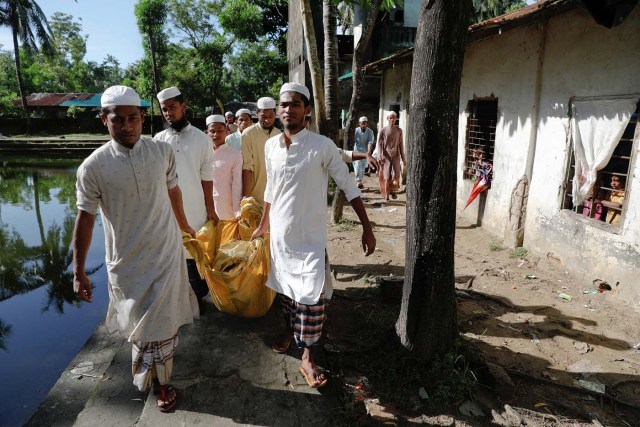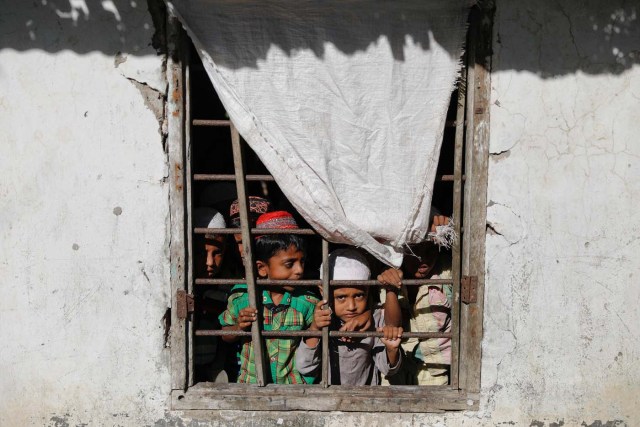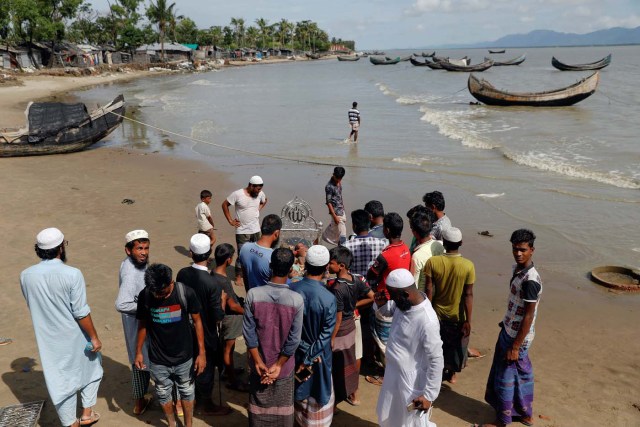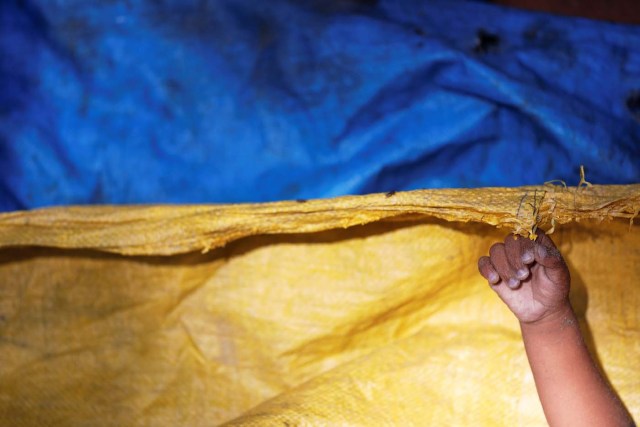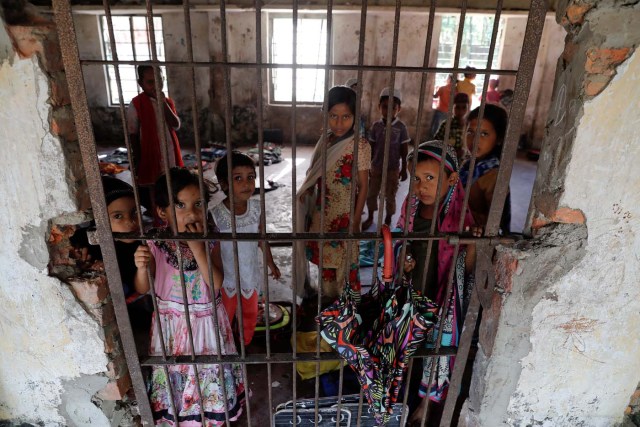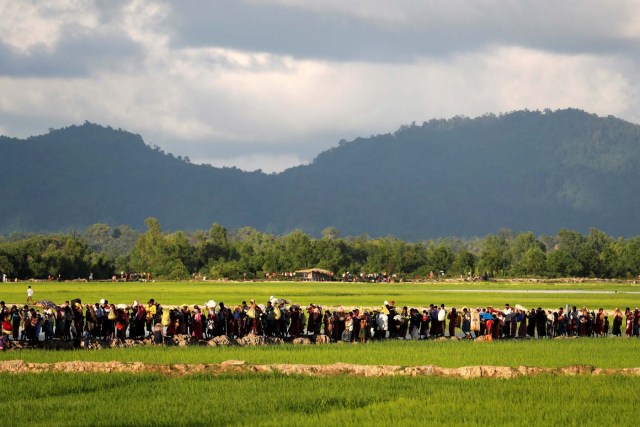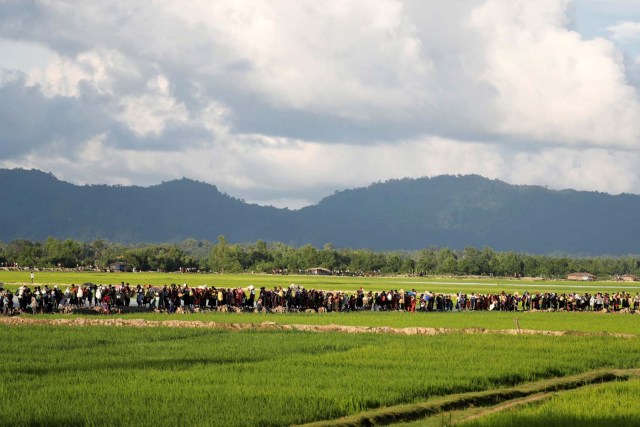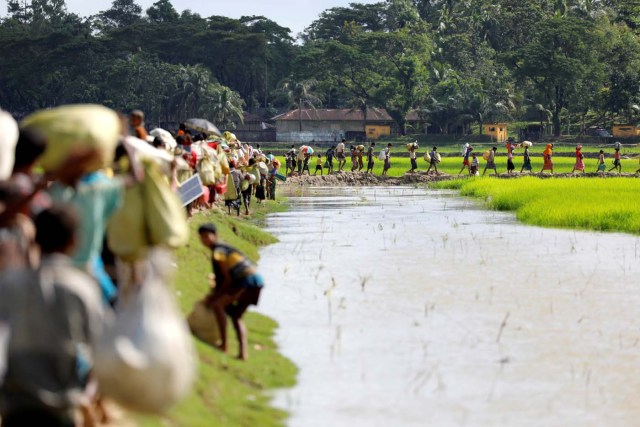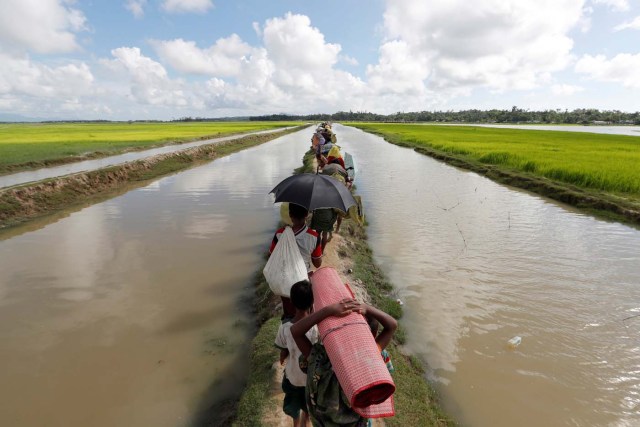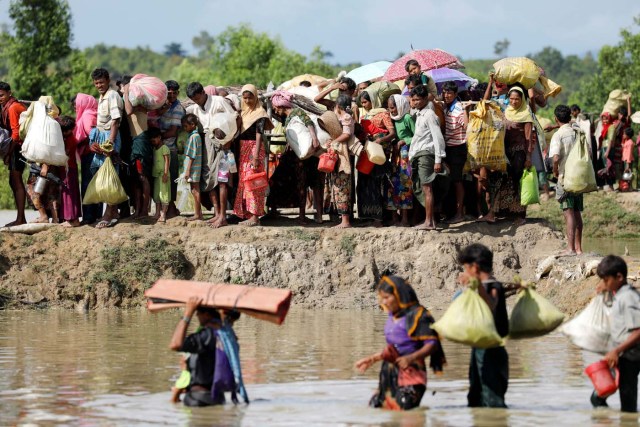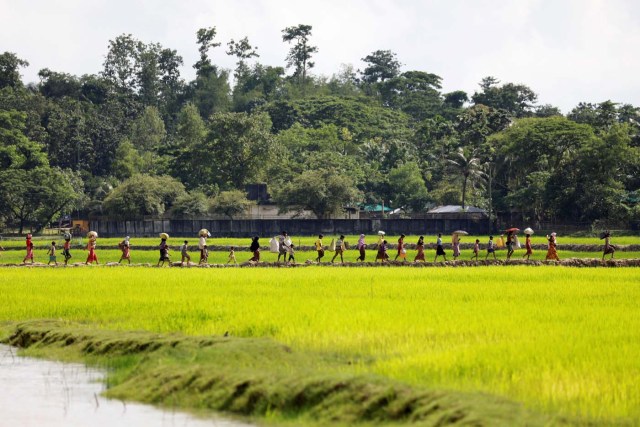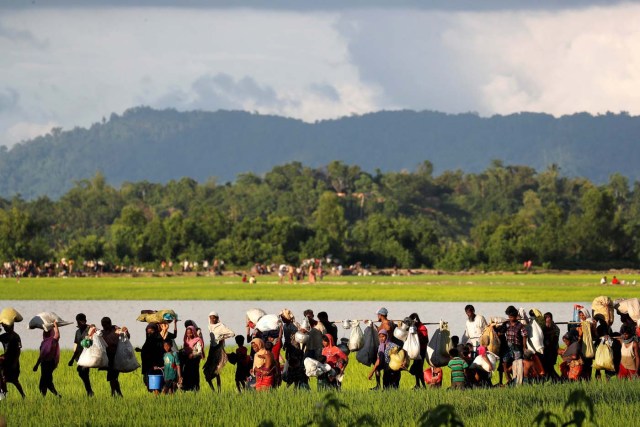
Al menos 14 personas murieron y decenas seguían desaparecidas tras el naufragio de un barco que transportaba rohinyás que huían de Birmania, en una nueva tragedia de esta crisis que ha llevado a más de medio millón de refugiados a Bangladés en seis semanas.
La embarcación volcó y se hundió el domingo por la noche en el golfo de Bengala, cerca de la desembocadura del río fronterizo Naf, que separa Birmania y Bangladés.
Los cuerpos de 11 niños, dos mujeres y un hombre fueron hallados en la isla de Shah Porir Dwip en Bangladés, y la guardia costera rescató a 13 supervivientes en el mar.
Alif Jukhar, un refugiado rohinyá que vive desde hace tiempo en Bangladés, perdió a nueve familiares en el naufragio, entre ellos sus padres.
“Ayer hablé con mis padres por teléfono y me dijeron que llegarían a Shah Porir Dwip mañana”, dice a la AFP mientras cavaba un hoyo con sus manos para enterrar sus cuerpos.
Poco después, abrumado por el dolor, Jukhar se derrumba y grita en medio del cementerio.
Desde hace semanas, los rohinyás desafían un mar bravío para huir de la violencia en Birmania.
Un guardacostas escruta el estuario del Naf. En la orilla opuesta, del lado birmano, se distinguen unos puntos de colores. Es un campamento de rohinyás, donde miembros de esta minoría musulmana esperan para intentar pasar a Bangladés.
“El mar está hoy agitado. Nunca se sabe por dónde van a llegar los cuerpos”, dice.
Por ahora, los equipos de rescate no saben ni siquiera cuánta gente iba a bordo de la embarcación naufragada: las estimaciones oscilan entre 60 y 100, según relataron los supervivientes, que mencionaron una mayoría de niños.
“Hemos hablado con varios supervivientes. Uno de ellos dijo que el barco transportaba de 80 a 100 personas, entre ellos 30 o 35 hombres”, declara Abdul Jalil, un responsable de los guardacostas de Bangladés. El bombero Rony Mitra habla de unas 60 personas.
– Final de la tregua –
El lunes por la mañana se habían hallado en total doce cuerpos: “diez niños, una anciana y un hombre”, indican los guardacostas, que rescataron a varios sobrevivientes.
Según las autoridades de Bangladés, varios pasajeros lograron alcanzar la costa birmana, cerca de donde ocurrió el naufragio.
La ONU considera que las Fuerzas Armadas birmanas practican depuración étnica contra la minoría musulmana.
Acusado de incendiar sus viviendas para incitar a los rohinyás a salir del país, el ejército birmano achaca la responsabilidad a los rohinyás. Las autoridades birmanas prohíben el acceso a las zonas en conflicto.
Ante las críticas, Birmania denuncia un sesgo favorable de la comunidad internacional hacia los rohinyás. Aung San Suu Kyi dirige el primer gobierno civil del país en décadas bajo la presión del poderoso ejército birmano.
Tras varios días de calma, el éxodo de rohinyás hacia Bangladés se reanudó, principalmente a causa de la falta de alimentos en el oeste de Birmania, donde según la ONU el sufrimiento es “inimaginable”.
Según las últimas estadísticas de la ONU, unos 515.000 refugiados huyeron de Birmania hacia Bangladés desde el 25 de agosto.
Unos 2.000 refugiados siguen llegando cada día, según la Organización Internacional para las Migraciones (OIM).
En total unos 150 rohinyás, muchos de ellos niños, se ahogaron mientras intentaban llegar a Bangladés en embarcaciones improvisadas que según los guardacostas no son aptas para la navegación en las aguas peligrosas del delta.
La mayoría huyen del estado birmano de Rakáin (oeste) hacia Bangladés después de que el ejército lanzara una campaña contra ellos, como represalia por varios ataques perpetrados contra comisarías el 25 de agosto.
Su llegada aumentó la presión sobre los campos de refugiados en Bangladés, que ya estaban atestados a consecuencia de anteriores brotes de violencia en el oeste de Birmania.
Los rohinyás, la mayor población apátrida del mundo, son tratados como extranjeros en ese país donde el 90% de la población es budista.
A causa de la discriminación, no pueden viajar o casarse sin autorización. Tampoco tienen acceso al mercado laboral ni a servicios públicos como escuelas u hospitales.
AFP
Fotos Reuters y AFP
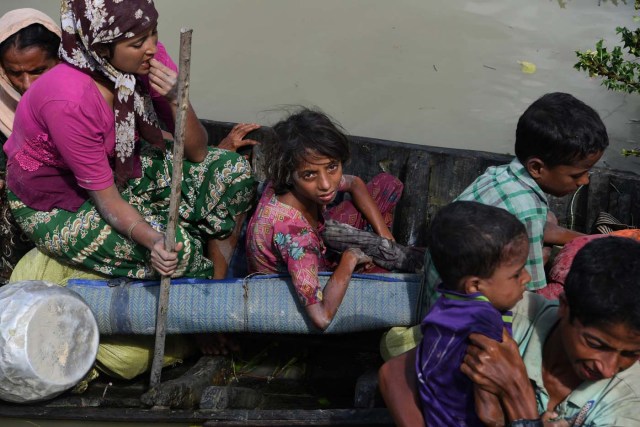
A top UN official said on October 7 Bangladesh’s plan to build the world’s biggest refugee camp for 800,000-plus Rohingya Muslims was dangerous because overcrowding could heighten the risks of deadly diseases spreading quickly. The arrival of more than half a million Rohingya refugees who have fled an army crackdown in Myanmar’s troubled Rakhine state since August 25 has put an immense strain on already packed camps in Bangladesh.
/ AFP PHOTO / INDRANIL MUKHERJEE
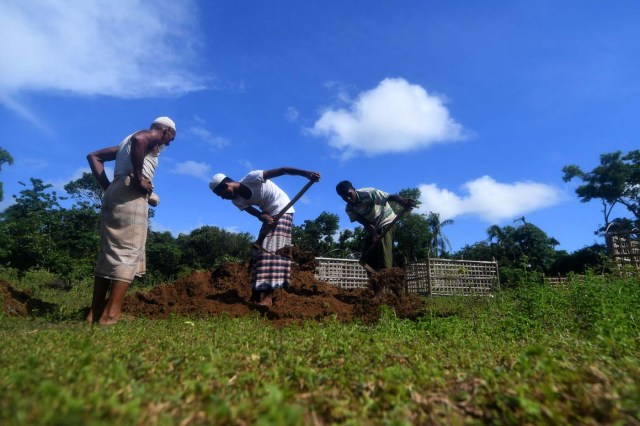
At least 14 Rohingya refugees, most of them children, drowned and scores more were missing on October 9 after their overloaded boat capsized in the latest tragedy to strike those fleeing violence in Myanmar. Authorities in Bangladesh said the boat was carrying between 60 and 100 people when it overturned and sank in rough seas on Ocotber 8 night. / AFP PHOTO / MUNIR UZ ZAMAN
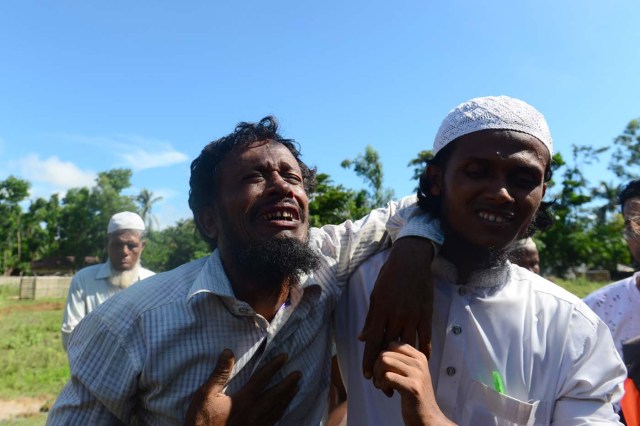
Alif Jukhar, a Rohingya refugee who has long lived in Bangladesh, lost nine relatives in the disaster including his mother and father. At least 12 Rohingya refugees, most of them children, drowned and scores more were missing on Ocotber 9 after their overloaded boat capsized in the latest tragedy to strike those fleeing violence in Myanmar. / AFP PHOTO / MUNIR UZ ZAMAN
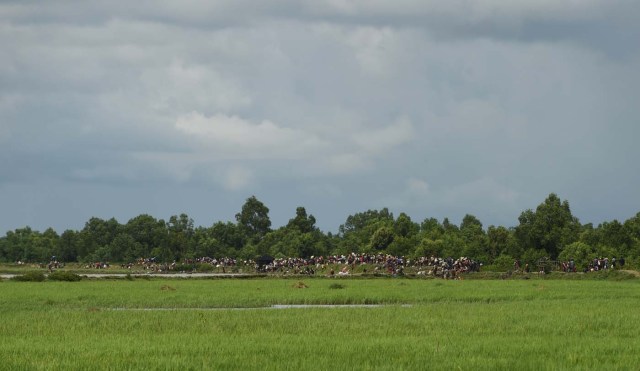
A top UN official said on October 7 Bangladesh’s plan to build the world’s biggest refugee camp for 800,000-plus Rohingya Muslims was dangerous because overcrowding could heighten the risks of deadly diseases spreading quickly. The arrival of more than half a million Rohingya refugees who have fled an army crackdown in Myanmar’s troubled Rakhine state since August 25 has put an immense strain on already packed camps in Bangladesh.
/ AFP PHOTO / INDRANIL MUKHERJEE
